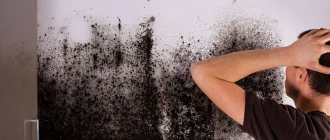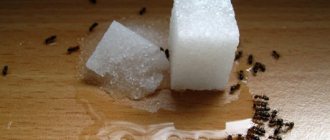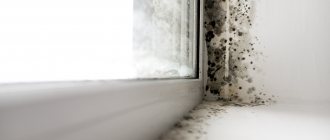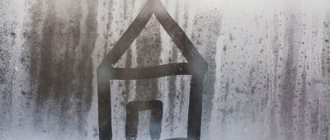A comfortable and cozy home is every person’s dream. For this reason, so much money is spent on cosmetic repairs, the purchase of upholstered furniture, remodeling and high-quality building materials. But no one is immune from the problem of high humidity levels - often the owners of houses and apartments complain that their homes smell of damp. They do not begin to deal with the problem immediately, leaving it until the situation becomes neglected. This is the wrong approach - it is much easier to get rid of dampness in the house if the problem has just arisen.
What causes high humidity in the house?
Dampness in the house is manifested by condensation on window glass and mirrors, dampness of things, a musty smell, wet spots on the wallpaper and under the ceiling. If nothing is done, mold will grow in the room.
Dampness and mold fungi in the house threaten:
- decreased immunity;
- destruction of supporting structures;
- chronic colds;
- failure of electrical appliances;
- allergies;
- the appearance of stains on furniture and wallpaper;
- asthma, etc.
High humidity
Dampness and mold in the apartment - impact on health
Increased humidity and dampness in residential buildings and diseases are closely related. The fact is that mold has the ability to multiply not only in the atmosphere of the house, but also to penetrate inside the human body.
Dampness can provoke in adults and especially children:
- upper respiratory tract diseases;
- pneumonia, bronchial asthma;
- pathological skin diseases;
- headaches and migraines;
- nosebleeds;
- stomach disorders.
Causes of high humidity in the house
You can deal with dampness in your home only by determining the cause of its occurrence. Natural reasons lead to an increase in humidity (washing, wet cleaning, cooking, steam formation in the bathroom, etc.). When breathing, one person releases up to 4 liters of liquid per day. These factors do not always lead to dampness; most often the reasons for high humidity are other.
Helpful advice. To find the source of dampness, you need to fix the glass against the wall overnight. It must be pressed tightly against the plane of the wall. If no condensation has formed on the glass by morning, the cause is dampness inside the room.
Humidity in the house increases due to:
- hanging wet laundry indoors;
- lack of a ventilation system or disturbances in its operation;
- plastering and finishing works;
- insufficient waterproofing of the foundation;
- increasing groundwater levels;
- lack of external insulation of the foundation;
- leakage of construction pits;
- defective drainage;
- uneven distribution of heat in the house;
- freezing walls;
- indoor plants;
- leaking roof, defects in roof overhang;
- walls lined with furniture;
- damage to water or sewer pipes;
- irregular or excessive ventilation;
- improper operation of the heating system;
- improper installation of double-glazed windows, their defects, high tightness;
- problems with thermal and waterproofing of walls;
- proximity to the sump;
- swimming pool located on the ground floor;
- damaged or clogged drain;
- aquariums.
What factors affect drying speed?
In fact, the drying speed is influenced by many factors: from the components of the plaster to the thickness of the layer.
But in order to delve into the topic of drying plaster in more detail, it is worth examining each of these parameters:
- type of plaster coating;
- features of the primer base;
- air humidity at the time of drying;
- general room temperature.
It is these factors that can be called the main ones influencing the drying speed of the plaster coating.
Reference! Additionally, you can study the manufacturer's notes on the packaging. It is there that the approximate drying times under certain conditions should be written.
Effect of layer thickness on drying speed
This is a completely logical point that directly affects the drying speed of the plaster. For example, if you take a thin layer of plaster, thanks to certain conditions it will dry quickly and efficiently. If the layer is thick, then, of course, it will dry much longer.
If we analyze the drying time using the example of a standard cement-sand composition, then under favorable conditions, after application, it will dry within two weeks. If you maintain the same favorable conditions, but the plaster layer is many times thicker, then it will take more than two weeks to dry.
Reference! Particular attention should be paid to the preparatory work that is carried out before leveling the walls.
How to reduce humidity levels in your home
To eliminate dampness, special equipment, preparations and folk remedies are used. Thanks to them, it is possible to significantly reduce humidity, but these are temporary measures. To completely get rid of dampness and prevent its reappearance, it is necessary to eliminate the causes.
How to determine humidity
You can dry the air using:
- Chemical preparations (Cerizite stop moisture, Stop Dampness, Drypet skit, Torrbollen, etc.). They act on the principle of a sorbent. Sold in hardware stores and online stores. They are mainly produced on the basis of calcium chloride.
- Air dryers. Air conditioners with dehumidification function.
- Heating devices (warm floor system, heaters, etc.).
- Home remedies (salt, rice, etc.). They are placed in the corners of the room.
There are four types of dehumidifiers:
- compressor units (can dry large rooms, but take up a lot of space and are noisy);
- with thermoelectric converters (they are quieter, but the power is much lower);
- adsorption (the stronger the sorbent absorbs moisture, the lower its efficiency becomes);
- rotary (combine the functions of adsorption and compressor equipment).
Note! Don't get too carried away with the fight against dampness. Low levels of air humidity are also harmful. Its optimal indicator is 45%. Humidity below 30% and above 60% is a violation. You can measure accurate data using a hygrometer.
Humidity measurement device
Home remedies to combat fungus and dampness indoors
There are many industrial compositions for combating fungus, and how to choose them and how to use them, check with specialists. We offer inexpensive, but quite effective home-made products made from scrap materials:
- Bleach will eliminate almost all types of fungi along with their spores. We must remember that under its influence some things may deteriorate. To treat the surface, use a mixture consisting of 10 parts water and 1 part bleach.
- Hydrogen peroxide 3% solution, which is applied to moldy surfaces by spraying, and after 10 minutes of exposure, all covered areas are thoroughly cleaned mechanically.
- Vinegar and soda: the affected areas are first covered with a layer of dry baking soda, and then filled with vinegar. At the end of the chemical reaction, all defects can be easily removed or washed off with water.
- A mixture of water and laundry soap can also act as a natural antiseptic and be used to combat mold.
- Tea tree oil, as well as soap solution, is used for minor problems. The method is to apply a mixture of oil and water in a ratio of 1:50 with a spray bottle and leave to dry naturally.
Humidity due to poor ventilation
Very often, the cause of dampness is poor performance of the ventilation system or its complete absence. After eliminating this problem, the humidity level can be significantly reduced.
Ventilation cannot work properly due to:
- obstruction;
- poor sealing;
- improperly equipped exit above the roof;
- insufficient cross-sectional area of the ventilation duct.
To restore normal ventilation, you need to invite a specialist. He will inspect the system and determine the cause of the problem.
A clogged system must be cleaned:
- remove the grille;
- wash it with detergent;
- remove dirt from the walls using a scraper;
- vacuum the channel;
- wash it with a damp cloth (as far as your hand can reach);
- put the ventilation grille in place.
The ventilation shaft is clogged.
At high humidity, you can use a forced ventilation system: reversible, exhaust or supply. It is installed in the ventilation duct. When there is no ventilation in the house at all, you need to make a through hole in the wall and install a recuperator in it. It must be covered with bars from the inside and outside.
Might be interesting
Waterproofing
How to choose the right floor waterproofing for screed?
Waterproofing
Foundation waterproofing: optimal choice of technology
Waterproofing
Clean water is the key to health, waterproofing concrete…
Waterproofing
Instructions for waterproofing a swimming pool
Another reason for dampness is improper installation of double-glazed windows. If mold appears on the window slopes, you need to level them and foam the cracks again. To prevent condensation from settling on the glass, do not clutter the window sills. This prevents the normal circulation of warm air. Window sills that are too large lead to the same consequences. To fix this, you need to drill holes in them.
Important! Fans, hoods and air conditioners need to be cleaned regularly. Otherwise, the device itself will become a source of bacteria and mold.
Windows that are too sealed are also a cause of increased humidity. How to lower the humidity level in this case? The problem of dampness can be solved using a window pressure ventilator, a hydraulically controlled ventilation valve or a vent fan. You can simply remove the rubber seal on top of the window frame. There is no need to do this with all double-glazed windows at once: first treat one window, then (if that doesn’t help) the next one, and continue until the result is obtained.
Ways to dry walls
We will provide several popular methods for drying plastered walls.
Ventilation
The ventilation path is the simplest and practically ineffective. Why?
- the option is relevant only in the warm season;
- humidity should not exceed 70%;
- you need a stable supply of air masses.
That is why the method is not effective.
Application of heat guns
Not a bad option, but it won't always work. Why?
- you cannot point the gun at the wall, otherwise the plaster will overheat and crack;
- ventilation is still needed to maintain the optimal temperature;
- constant adherence to temperature conditions;
- You can use the gun for no more than 6-8 days.
The method is budget-friendly, not bad, but not the best.
Application of dehumidifier
This method can be used always and everywhere. In this case, you do not need to constantly monitor humidity and temperature, and the device will ensure quick drying of the plastered surface.
The source of moisture is under the floor
If there is no ventilation in the underground, it is necessary to equip it. Waterproofing walls and floors, sealing gaps and cracks help to significantly reduce the level of humidity at home. For this, waterproofing plaster is used.
Dampness in the cellar may appear due to leaky construction pits. To eliminate the problem, you need to seal it with waterproof clay (clay castle).
Foundation drainage device
Changes in groundwater levels lead to dampness in the house. To solve this problem, you need to properly organize the drainage system.
Another reason is poor foundation waterproofing.
In this case, vertical waterproofing is necessary:
- coating waterproofing;
- penetrating compounds;
- vertical lining of the foundation with waterproofing.
Note! The service life of waterproofing materials is not infinite. In an old house, it may be out of order.
What are the features of drying?
Drying features are indicated depending on the environment where the plaster is drying.
Room
If the walls are plastered indoors, this will happen quite quickly, regardless of weather conditions.
For favorable conditions, it is enough to ensure optimal temperature and humidity. Most manufacturers write drying times for their compositions specifically for indoor environments.
Important! Do not forget that the cement-sand composition shrinks after application.
Street
Plastering work is best done in the summer. Under the influence of warm temperatures and normal air humidity, the plaster composition will dry much faster.
If the temperature is less than 15 degrees, this will increase the drying speed.
The cause of dampness is the roof and walls
Conventional heating methods help warm the air in the home. They are not able to warm up the walls. Condensation forms on cold surfaces. Because of this, the humidity in the room increases.
You can correct the situation using:
- heating convector;
- infrared heater;
- increasing the footage of the heating system;
- arrangement of heated floors;
- thermal and waterproofing of walls.
Note! Do not apply finishing materials with high acidity to affected surfaces. Mold spores thrive in such an environment. It is better to give preference to compounds with a neutral or alkaline reaction.
When dampness “sets in”, wet stains appear on the wallpaper, mold spots appear on the ceiling and under it. This is caused by holes in the roof and damaged gutters. Waterproofing the ceiling will not help here. The water will soak into the walls and still seep into the house.
The work must be done from the attic side. To eliminate the causes, it must be examined. Then, if necessary, carry out waterproofing and restoration work. It is necessary to carefully treat the cracks, cracks and joints. Clogged gutters can be cleared out using a garden hose.
Prevention is the key to victory
If a person, in principle, does not want to get involved with any problem, then he does everything to avoid a collision with it. It is easier to deal with excess moisture and the smell of dampness if you prevent mold from occurring. It’s easy to miss this moment - the fungus spreads instantly. Therefore, you need to get rid of dampness in bathrooms, living areas and other places as soon as the problem is noticed.
- We remove all items for drying clothes from the rooms. Linen should be dried on the balcony or outside. The maximum that can be allowed is underwear on heated towel rails in bathrooms. There should be no duvet covers or clothing in living rooms.
- Installing a good drainage system will save you from dampness in a private home. It is worth remembering that such houses are constantly attacked by dampness not only from the basements, but also from the outside - rainfall, groundwater, and your own garden also affect it.
- Don't skimp on heat. During the warm summer season, repair the heating system in your home, and during the repair, do not spare money on good insulation. If this does not help, then an air conditioner would be a good solution - it dries the air well.
- It is necessary to quickly eliminate all leaks from faucets, external seams, roofs and everything else in the home.
- Make airing a regular ritual - this will not only help fight humidity, but is also generally very good for health.
- Lovers of indoor flowers should avoid violets and geraniums - mold lives and reproduces well on them.
- If there are places in the house or apartment that have not yet caused inconvenience, but are already at risk, then work proactively - the walls will not be harmed if they are once again treated with an antiseptic against mold.
- Buy a hydrometer - a device that indicates the level of humidity in a room.
- Sunlight also removes dampness, although not completely. Therefore, open the curtains and windows, especially in the summer.
- Pay attention to carpets, rugs and paths - clean them as best as possible and dry them completely. It's the same with furniture.
What to do if the cause is dampness indoors
Installing a heated towel rail in the bathroom
When high humidity in the house is not associated with poor ventilation or violation of construction technologies, it is much easier to deal with it. You just need to follow certain recommendations.
To prevent the humidity level in the house from increasing, you need to:
- during the daytime (especially in summer) keep the curtains open;
- do not put undried laundry in the closet;
- check the integrity of water and sewer pipes and eliminate defects;
- reduce the humidity level in the kitchen using a hood;
- perform 5-minute through ventilation 3 times a day;
- during cooking, reduce the heat so that the container can be tightly closed with a lid;
- if it is impossible to dry clothes outside the house, let things drain over the bathtub, then hang them closer to the hood;
- keep interior doors open in the house;
- on the doors of wet rooms, install ventilation holes at the bottom (from 200 sq. cm);
- do not place furniture close to the walls;
- When wet cleaning the house, wring out the rag well;
- do not keep filled buckets and bathtubs for a long time;
- reduce the number of flowers in the house, reduce the frequency and volume of watering.
Helpful advice! Installing a heated towel rail will help reduce the humidity level in the bathroom. It can be electric, water, combined.
How to dry walls in winter
In winter, this procedure is quite problematic. What to do in such a situation?
Compliance with conditions
When applying plaster to walls in winter, certain conditions must be observed:
- monitor the humidity of the walls;
- ensure favorable room temperature;
- carry out preparatory work correctly;
Once these conditions are met, you can proceed to the next step.
Relationship between plaster and frost
If you have to plaster the walls in severe frost, then there is an unusual life hack. You can add a chemical to the composition and not worry about the temperature in the room and freezing of the walls.
Chlorine
If you add chlorine, then plastering work can be done even at -25 degrees. True, such water needs to be heated to 35 degrees and only then add lime to the water.
Application of potash
This method is only suitable for reinforced walls. The composition is used primarily for cement mortars.
Important! Potash does not cause metal corrosion and can be applied directly to the mesh.
Ammonia bases
If you use ammonia, you can carry out plastering work even at -30 degrees.
Important! To prevent ammonia from dissolving, the temperature of the liquid should not exceed 5 degrees.
How to deal with the companion of dampness - mold
How to deal with mold
The lesion is formed due to high humidity. To prevent its occurrence, you need to understand why dampness appeared in the house. Only by eliminating the cause can you completely get rid of mold.
They fight lesions in the house using various compounds:
- mildew removers:
- antiseptic primer;
- 3% hydrogen peroxide solution;
- soda solution (1 tsp per 200 ml of water);
- alcohol;
- urea solution (temperature 50 degrees);
- 10% bleach solution, etc.
Important! Hydrogen peroxide and bleach can lighten the surface. They must be used with caution. You can use the products on painted surfaces, but only after checking the durability of the coloring pigments (in a small area).
The surface must be prepared before treatment. The wall needs to be cleaned of wallpaper and plaster. Then dry it thoroughly using a heater. After this, you can begin surface treatment. Anti-mold agents must be applied to the affected surface. Then dry the wall thoroughly.
Dampness and mold in the house are dangerous to health. They lead to the destruction of building structures and damage to property. Humidity in a home can increase due to various factors. If the problem is caused by human activities, dehumidifiers can help. In other cases, it is necessary to find out the causes of high humidity in the house and eliminate them. Otherwise the problem will return again and again.
Fungus on the floor and mold under linoleum, laminate
Often unwanted moisture accumulates under linoleum. It is there that all the conditions are created for the development of mold, which is almost impossible to get rid of completely and the coating has to be changed.
In this case, it is advisable to observe the following:
- Under no circumstances should old materials be laid on floors affected by mold.
- The fungus often spreads to the walls, so you should cut off the lower part of the wallpaper adjacent to the baseboards;
- When installing a new coating, it must be treated with antifungal drugs.
Source of moisture
Sources of moisture in the apartment:
- precipitation: rain, melting snow, condensation can enter the apartment through a leaking roof, through wall pores and unsealed seams (especially if the wind, improper roof overhang or defective drainage constantly direct precipitation onto the wall);
- stagnation of water in the apartment: leaking plumbing equipment, swimming pools, baths, aquariums, including those located on the floor below; the same effect is achieved by running a bath or taking a long shower;
- the greenhouse effect from poor ventilation of windows (condensation accumulates on the glass), an abundance of indoor plants, especially if they need abundant watering;
- The breathing of people, animals, and plants also increases humidity - usually this factor is not noticeable, but in cramped and / or poorly ventilated rooms it will be noticeable.
Near a private house there may be chambos or septic tanks that saturate the grant with moisture. As a result, the basement becomes very damp and mold develops in it. Another source of moisture in the basement and on the 1st floor is a split blind area (a waterproof covering located around the perimeter of the house). Moisture from the soil and precipitation will seep into the house or basement.
An unheated room is a refuge for dampness. Ideally, the walls of an apartment or house should be heated to at least half their thickness, then the place where condensation forms will go outside (to the street). In frozen walls, the place where condensation forms is shifted to a warm area, and is often even located on the surface of the walls on the residential side. The problem is aggravated by poor ventilation of the premises.
Housing where no people live or which is not heated enough begins to become damp very quickly: the wall decoration is destroyed on average in two seasons. In addition, in addition to natural wear and tear, the structure loses an additional 5% of its strength every year due to dampness.
Advice! A country house, a dacha - no seasonal housing should be left without heating. Hire a person or arrange with a neighbor who will periodically monitor this. If you are going away for a couple of weeks, do not close the battery valves.
Improper insulation also causes dampness. The main mistakes are an insufficient layer to provide warmth, and poor materials with zero vapor permeability.
To properly insulate an apartment, you can use one of two options:
- The thickness of the polystyrene insulation layer is within 10-15 cm (and this is relevant for any region of the Russian Federation).
- Use vapor-permeable material as insulation, for example, ecowool, mineral wool. This will make it possible to ensure that moisture in the walls is removed.
Useful tips for prevention
- Do not dry clothes in the apartment. It is better to do this outdoors, on the street or balcony. If this is not possible, you can purchase a washing machine that has a “drying clothes” function.
- After taking water procedures or hand washing, ventilate the room.
- When purchasing plastic windows, give preference to options in which the frames are equipped with a ventilation system, since it is plastic bags that do not allow air to pass through.
- If you have an aquarium, decorative fountain or indoor waterfall, it is better to abandon them.
- If you like indoor plants, it is better to purchase those species that do not require frequent watering, such as cacti.
Quality air in your home has a beneficial effect on your health. Knowing how to reduce humidity in an apartment and maintaining these indicators within normal limits, you provide yourself and your loved ones with comfortable living conditions.
Injection or invasive methods for drying buildings
Generally speaking, injection involves the creation of a special sealing or hydrophobic barrier. This barrier is created by removing moisture and introducing special preparations in its place.
We can say with confidence that injection is an effective method for drying foundations in used buildings.
Crystal injection
Crystal injection - used to dry capillary moisture that is drawn from the ground into the foundation.
Capillary moisture occurs due to the accumulation of water in capillaries (microchannels in building materials). Water moves along with capillaries through the building, causing the walls to become damp.
Crystal injection involves extruding special injection channels into the wall. A mixture of water, Portland cement and silica activator is poured into the ducts.
Crystal injection works based on a diffusion activator that spreads within a few centimeters of the channel.
Thus, a certain vertical isolation of the foundations is created. It is worth adding that crystalline injection is characterized by very high drying efficiency.
Particularly recommended for drying poorly insulated substrates made in old buildings. The price for drying an apartment using crystal injection is determined individually.
Heat injection
Thermal injection - looks very similar to crystal injections. Can be used to release capillary moisture.
Holes of the appropriate diameter are drilled in the wall. Then a stream of hot air is introduced into them, which is intended to dehumidify and dry the walls.
After initial drying, the holes are filled with methyl silicone resins, forming a powerful moisture barrier. This type of injection is very effective.
However, its biggest advantage remains its speed. Drying the walls takes only a few hours. The price for drying old buildings using this method depends on the degree of humidity, the specifics of the walls, as well as the size of the foundations.











